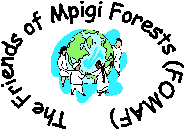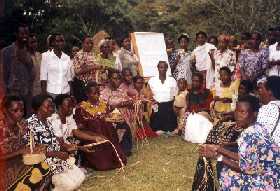The role of women in conservation of forest
reserves in Mpigi, Uganda.
By Kunga Ngece* and Mildred Nafuna**- Friends of Mpigi Forests
Conservation and Development Organization (FOMAF).
· Technical Adviser, ** Coordinator.
Introduction.
Mpigi district, Uganda, boasts of about 40 forest reserves, all of
which have been invaluable to the people living around them. An
impoverished people, with nothing else to depend on, surround the
reserves. 90% of these reserves have been massively encroached on,
and as a result, biological diversity has been drastically
decreased. Exploitation of resources in these forests has been so
haphazard, excessive, wasteful and uncontrollable, seriously
affecting the ability of these forest reserves to recover. The
forests are a major catchment area for the rivers emptying waters to
Lake Victoria, an international water body serving hundreds of
millions of people. Forests such as Lufuka, Kyansozi, Nsowe, Lwamuda,
Navugulu, Kalandazi and Kalombi have been seriously encroached on,
and provide much of the charcoal, timber, and poles for the
up-market Kampala, 40 kilometers away. They are also a major source
for drum flames, medicinal herbs, wood for burning bricks, sand and
clay. There has been a proliferation of drum business in and around
Kampala, as well as in Mpigi itself, most of which derive their raw
materials from the Mpigi group of forests. Only one forest remains
intact in Mpigi, Mpanga forest.
The Mpigi group of forests cover about 260Km2, ranging from
1150-1190 meters above sea level. The forests are of great
biodiversity potential, and host 28% of Uganda’s total plant
specie. Some of these forests are classified as Guineo-Congolian
rainforests, once a block of dense forest joining Western Kenya,
across Uganda and Zaire. This summarizes their role in conservation
of important and rare specie found in no other parts of the world.
These forests hosts over 190 bird species, 198 butterfly species,
170 species of moths, 20 species of small mammals and a host of rare
insects. Two species; Crotolaria recta and Ficus
wildemania are found only in these forests in the whole of
Uganda. Others such as Acalypha acrogyna, Schefflera volkensii,
Bruce antidysentrica, Psychotria succulenta and Tarenna
fusco-flava are rare species found here (Davenport et al, 1996)
. The forests used to host the Uganda Red colobus, included in the
IUCN red data book as vulnerable (Oates, 1996) which has since
been eliminated from them. The spotted Greenbul (Iconotus
guttatus) Bat Hawk (Macheiramphus alcinius), Shining-blue
Kingfisher (Alcedo leucogaster), Uganda Woodland Warbler (Phylloscopus
budongoensis) and the Pink-coated Puffback (Dryoscopus
angolensis) a rare species in Uganda found in the Mpigi group of
forests (Davenport et al, 1996). A total of 12 restricted range
butterfly species and 12 restricted range moth species are common in
the forests.
In 2001, a project trying to conserve these forests and promote
economic development in the area was initiated. Through funding from
the European Development Fund, funded Forest Resources Management
and Conservation Programme of the Forest Department, Uganda and
Voluntary Services Overseas, Uganda Programme Office, programmes
targeting mainly women and youth as well as school children were
started. The programmes include a Reforestation and Agro forestry
project, an Environmental Education Project, the hoarse radish (Moringa
oleifera) tree and Neem (Azadirachta indica) tree
project, a Bee keeping project as well as a Sustainable crafts
project. The projects have had tangible positive results as far as
development economics and conservation of forests in Mpigi is
concerned.
In 2002, women in Mpigi district on a quest to bring resources
together for the sake of their families and conservation decided to
form a steering committee to oversee their crafts programme. The
women mandated FOMAF to oversee the programme. The women also
decided to implement an Ecotourism and environmental education for
schools programme.
Membership to the crafts programme stands at approximately 200
women, translating to a representation of 190 families. The
environmental education programme has reached 17 schools of the
about 100 in Mpigi district. Approximately 1000 seedlings of Moringa
tree and 200 seedlings of the Neem tree have so far been planted by
members. A further 3000 seedlings of Setala and 1500 of Eucalyptus
have been distributed around the district.
Key objectives o the programme.
At the time on inception of the Friends of Mpigi Forests
Conservation and Development Organization, the major objective was
to conserve forests and wetlands in Mpigi district. The programme
however realized there were other problems associated with
deforestation of forests, which had to be tackled before forest
conservation could be realized. The HIV/AIDS pandemic had rendered
many families poor, many widows and child headed families were in
place, and there was no way you could convince them not to encroach
to the forest when they had nothing to feed on. Most of the people
living in Mpigi are poor, and family planning was an issue to be
tackled first. The family leaders, especially women had to be
empowered financially to enable them feed their families. It was
also realized that schools environmental education programmes were
vital so that the programme could reach a greater audience through
school children. Involvement of women and youth in Ecotourism was
perceived as a way of positively and practically educating them on
other values of forests, and other ways in which income could be
generated from forests, instead o direct encroachment.
If these issues were successfully met, then conservation of forests
in Mpigi could be achieved. And the project does not only target
women and the youth, but men are encouraged to participate in
programs such as bee keeping. Some of the forests in Mpigi that have
benefited from these programs include Mpanga, Lufuka and Kyansozi,
today living examples of how women can successfully promote
conservation through crafts, Ecotourism, environmental education and
agro forestry.
Gender mainstreaming, as a way of forest conservation.
Mpanga forest reserve in Mpigi is a living example of how Ecotourism,
crafts and environment education can enhance conservation and
protection. An Ecotourism site at Mpanga, under management of the
Forest Department has played a key role in employment and revenue
generation, some of it ploughed back to the local people. Villagers
have also benefited by providing catering facilities to visitors,
while nearby traditional shrine owners earn direct income from
visitation by tourists. Initially, the people sabotaged the Ecotourism
sites programmes by tree felling in the forest due to a feeling that
the people were being denied access to their own resources from the
forest. People utilized the forest for resources such as flames for
the drum market, poles to support banana stands, poles for building,
timber, charcoal, sand, clay, medicinal plats, mushrooms, wild
honey, papyrus, raffia palm, bisalu grass, mud fish, pine sap, small
mammals and birds for food. Farming in the forest was also
extensive. People had to be made to understand the essence of the
forest reserve, which is also the only source of clean drinking
water through its network of underground streams.
To enable the people understand why the programme was concerned
about Mpanga forest, an environmental education programme was
initiated for both schools and the community. Use of the local
administration was important to enable people understand issues
further. The programme also utilized the power of the woman in the
house, as the major consumers of the forest products. Most of the
meetings were also attended chiefly by women, who also participated
in the planning process of meetings held to educate them on forest
values.
The Sustainable Craft Project: A positive example of women in
conservation and development of Mpigi district.
Women through the sustainable crafts programme have contributed to
conservation of Mpanga forest reserve. The project, funded by VSO
Uganda and the EDF funded FRMCP was able to train 200 women in
making export quality crafts using local materials, sustainably.
These are exported to Europe, or sold in the local tourist
destinations, at fairer prices than they would fetch if sold
locally. 30 trainers were also trained. Their work is to follow-up
the craft project and shows other women ways of making international
market selling designs.
The impact of the craft project has been immeasurable. This means
about 190 families now have direct income from sale of crafts. This
multiplies to about 1000 individuals directly benefiting from craft
income. As a result, people now view forests with more interest, not
on what they can directly utilize them, but how they can use them to
raise some income, while maintaining their intact state. Through the
craft project, many families have been able to plant trees as
Moringa and Neem, which are also a source of food, and have medical
qualities. The craft project alone has distributed 200 trees to
women participants.
Through the project, a forum for educating women on socio-economic
issues in the society was created. During one of the training
sessions, a local women counselor and the district Gender, culture
and youth official delivered important speeches, that were
captivating and have impact to the ways of life of the women. Among
the topics discussed included family life, HIV/AIDS prevention as
well as community relations. Information on the essence of forest
conservation is also passed on during these sessions
The impact has been good. Mpanga forest is today not as encroached
as it used to be 3 years ago. Some of the patches that had been
created due to farming in the forest have almost recovered. Drum
businesses along the Kampala-Masaka highway that depended on flames
from the forest have had to find alternative sources of these
flames. While Mpanga has been considerably conserved, these forest
encroachers might be shifting their bases to other nearby forest
reserves, which require similar programs to counter illegal
encroaching. Finally, people have understood why they seriously need
Mpanga forest. It’s the source of livelihood for thousands of
people depending on its waters. This makes the FOMAF’s Sustainable
Crafts Project a mouthpiece for development and conservation in
Mpigi district, from which other forest reserves need borrow a
leave.
FOMAF
SECRETARIAT. C/O VSO UGANDA. PO BOX 2831. KAMPALA. UGANDA.
TEL
256 (0) 77 580935/ FAX 256 (0) 41 510090.
Copyright 2003, Friends of Mpigi Forests
Conservation and Development Organization. All rights reserved.
|

